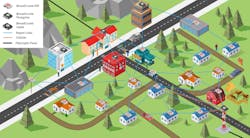Mesh Networking: The Bridge Across the Digital Divide
How to solve the dilemma of connecting rural America.
High-speed connectivity is no longer a luxury but a necessity. Without it, people are at a disadvantage. The phrase “digital divide” refers to the inequality of access to high-speed broadband service in rural areas compared to urban areas.
The reason for the digital divide is simple mathematics. Rural areas have considerably lower building density. Fewer houses and commercial buildings mean fewer potential paying customers. On top of that, if potential customers are spread out, the cost of installing fiber optic or coax cable is much higher per structure compared to densely populated cities due to the empty land between service hook-ups.
Many people think satellite connectivity is the only solution for wireless broadband in rural areas. And while the top satellite providers can reach impressive speeds, it is not cost-effective for everyone residing in a rural area to pay the expensive monthly rates.
The challenge of overcoming the digital divide is still getting worse. Many people in the United States do not have electric utility services in their homes because of their remote location. If people do not have utility service, they do not have power poles along their street, which means internet infrastructure must be buried, which is more costly than stringing fiber or coax between existing power poles.
If internet service providers (ISPs) must spend more money to install communications infrastructure in rural areas, and there are far fewer potential customers to collect service fees from, the potential to recover the cost of installing broadband is less. Telephone utilities, cable companies, fiber optic companies, and ISPs must make spending decisions based on the cost versus revenue equation.
Governments worldwide have recognized this issue and, in some cases, have invested millions in providing network infrastructure in low-income and rural areas to ensure no one gets left behind. Every time a wired or wireless telephone bill in the United States is paid, a contribution is made to the Universal Service Fund. This fund makes low-cost loans available to carriers to motivate them to deploy communications services to rural America. Unfortunately, many people still find themselves disconnected from the digital divide.
A 2021 Study1 by BroadbandNow Research confirmed more than 42 million Americans do not have broadband access. While this number is much greater than FCC figures, the study also pointed out that the FCC relies on self-reporting data by ISPs instead of any type of actual survey.
Perhaps the most challenging part of connecting rural customers is the "last mile." The “last mile” is the final part of the network that connects homes and buildings to the extensive backhaul of the network.
This responsibility is often passed to wireless providers to cover the often isolated and robust “last mile.” Many people think satellite connectivity is the only solution for wireless broadband in rural areas. And while the top satellite providers can reach impressive speeds, it is not cost-effective for everyone residing in a rural area to pay the expensive monthly rates. What is needed is a cost-effective wireless broadband solution that can provide sufficient connectivity and bandwidth.
Essential Services for Rural Communities
The COVID-19 pandemic highlighted the crucial role that high-speed internet access plays in each person’s life. When face-to-face contact was actively discouraged, schools and offices shut down; people needed broadband to work from home, access health care services, order food or prescriptions, and education. In the United States, 97% of the country’s land mass is rural, with 19.3% of the population2 inhabiting it. This means that around 60 million people are geographically disadvantaged when it comes to broadband connectivity.
Many factors make internet access even more vital, especially for rural towns and their residents. Rural residents are more likely to be older, which makes them more susceptible to health issues. A poor connection can be an issue for health providers who may struggle to reach their patients directly. Health providers also rely on internet connectivity for remote patient monitoring and online appointments.
Until March 2020, Mountain Comprehensive Health Corporation, based in Kentucky and one of the largest rural community health centers in the United States, fielded 1,500 telehealth calls. From March 2020 through September that number skyrocketed to 156,000,3 demonstrating broadband’s critical role in healthcare access for people in rural areas.
Another example is the Navajo Nation, located in the four-corner area of the Southwestern region of the United States. The Navajo Reservation is home to the Navajo, Hopi, and Piute bands of Native Americans. The school district that serves the Navajo Reservation has the highest number of missed school days in the United States.
Over 60% of people on the Reservation live on paved roads. Most of the streets in the Southwest are susceptible to washout due to the high content of sand in the earth. Every time it rains, the roads are impassable, and the school buses cannot pick up children.
A missed school day is no big deal for students on the fortunate side of the digital divide. They can access school-issued laptops, attend a web meeting with their teacher, and have class at home. However, students living on the Navajo Reservation miss so many school days that it is impossible to schedule enough makeup days. This vicious cycle repeats year after year.
Broadband services are also crucial for other public-sector organizations and for businesses. Businesses in rural areas need internet connectivity to process credit card transactions. With improved internet access, they have a much better chance to grow, equating to more jobs and higher household incomes.
Fast rural internet is also essential for many aspects of the modern workplace, such as streaming, downloading, and participating in video calls. For municipal use cases, such as emergency services, limited bandwidth or sporadic connectivity can mean the difference between life and death.
I will give you an example. I live in a suburb of a good-sized city. I do not have a utility telephone service to my house by choice. Everyone in my household has cell phones. Even though cell service is not excellent, we have a gigabit fiber connection feeding our home Wi-Fi.
This allows me to work from home, my daughter to take college classes at home, and all of us to shop, make phone and video calls, and stream entertainment. If my fiber service goes down, I can walk onto my front porch to make a cell call. However, millions in rural America may have none of these options. No utility telephone service, cell service, or broadband internet service. What do they do in an emergency? At best, they get in their car and drive to the nearest town with the needed services. Working from home or attending school at home is not an option. The unfortunate side of the digital divide is not a convenient place to live.
Considering Both Fixed and Wireless Options
The “last mile” is one of the network’s most expensive and complicated parts to build and operate. Rural areas are isolated and remote, making cable deployment costly. Existing infrastructure in rural areas is often outdated, meaning the rollout of new technologies, such as fiber, is much slower. Customers generally have fewer service options and slower internet speeds. While a fiber optic service is fast and reliable, getting fiber to every door in rural areas is expensive.
Several wireless technologies are also available, such as 4G/5G LTE service. Cellular infrastructure is expensive. When cellular carriers build out their network in urban areas, they can afford a higher density of towers, which provides more capacity and faster data rates. However, building in rural areas is all about providing minimal coverage to most people. Some people are invariably missed, while others live in topographically challenged places that are inaccessible with minimal infrastructure.
Satellite’s wide availability and broadband speeds of up to 250 Mbps present another option for customers living in rural areas. However, as mentioned above, satellite is an excellent option if you can afford the cost of the equipment and the high monthly service costs. My suburban internet costs nothing for installation and equipment, and I pay less than half of what a satellite customer would pay, and I get 4x the data rate.
It’s essential to remember rural areas have lower median incomes when compared to urban areas (23% rural-urban gap).4 In addition to paying a higher price for service, rural home workers could also experience high latency due to the distance the satellite signal has to travel. This is particularly problematic when video conferencing. Weather can also interfere with service.
Supporting Rural Communities With Reliable and Robust Connectivity
As societies and lifestyles evolve in this age of technological interconnectivity, it is important that broadband networks can also move with them. A mesh network can do precisely that. It can enable a seamless and quick deployment for ISPs that is robust enough to navigate the most challenging rural terrains.
Mesh networks such as Rajant Kinetic Mesh can deliver broadband speeds of over 200Mbps5 to multiple municipal buildings, exceeding the Federal Broadband, Equity, Access & Deployment Program (BEAD) requirements of 100 Mbps for underserved communities and 25 Mbps for unserved communities.
Rajant’s mesh network is made up of wireless nodes called BreadCrumbs. These can be deployed on buildings, poles, or any physical structure to extend coverage of existing network infrastructure, including fiber, satellite, and LTE technologies. They only require power, which can be provided by existing utility services or solar. Unlike wireless point-to-point or microwave, which transport signals from point A to point B, BreadCrumbs can transport signals from point A to point B and provide usable signals in between. BreadCrumbs mesh and provide reliable, longer-range Wi-Fi compared to a traditional access point.
BreadCrumb nodes extend broadband over the “last mile” to schools, government buildings, and even homes. In essence, mesh networking can provide “Smart City” enablement of Internet of Things (IoT) devices such as traffic lights, surveillance video, public Wi-Fi, and public safety equipment. In addition, anyone with a commercial off-the-shelf client device, like laptops, tablets, and smartphones—can connect to the Kinetic Mesh network.
Mesh networks are resilient to physical and RF interference. The mesh nodes create a self-healing network by forming multiple redundant connections and then using them to relay information and data to ensure no single point of failure. This means that data can keep moving even if a single node is damaged or lost, enabling anywhere connectivity. The ability to leverage multiple paths and frequencies also provides high capacity to guarantee the performance of bandwidth-intensive applications.
Mesh Networking: Moving With the Digital World
The rollout of broadband has ramped up in rural areas worldwide over the last few years thanks to an increasing focus by governments and ISPs on the “digital divide.” The global percentage of individuals using the internet in rural areas (46%) was 1.8 times lower6 than in urban areas (82%) in 2022—decreasing from a 2.3 ratio difference in 2019.
As digitalization and technologies evolve and become more advanced, broadband networks must move with full mobility to expand and enhance connectivity. Wireless mesh networks can ensure that 24/7/365 high-speed internet is provided to every corner of the world and connect the underserved and unconnected.
Rajant is committed to assisting communities and service providers with creative solutions for rural broadband initiatives. You can contact Rajant to learn more about Kinetic Mesh.
REFERENCES
-
BroadbandNow Research study, broadbandnow.com/research/fcc-broadband-overreporting-by-state
-
“What is Rural America?” census, www.census.gov/library/stories/2017/08/rural-america.html
-
“The Rural Broadband Challenge,” www.youtube.com/watch?v=-_SajUuCHYs
-
The Rural-Urban Income Divide Persists, and it may be Widening,” www.marketplace.org/2023/11/30/rural-urban-wage-gap-covid/
-
“The Great Divide: Broadband Challenges in Rural America,” rajant.com/the-great-divide-broadband-challenges-in-rural-america/
-
“Internet Use in Urban and Rural Areas,” www.itu.int/itu-d/reports/statistics/2022/11/24/ff22-internet-use-in-urban-and-rural-areas/
About the Author

Todd Rigby
Director of Sales, Rajant Corporation
Todd Rigby is Director of Sales at Rajant Corporation. For more than 25 years, he has been deploying communications systems and technology solutions across multiple industries. He has successfully helped numerous companies with various digitization and Industry 4.0 initiatives. These efforts have improved safety, productivity, asset utilization, and output. Todd has firsthand experience with many different communication technologies, and their application to various industrial use cases. He is the subject matter expert in the United States for Mining, Heavy Construction, Agriculture, Material Processing, Manufacturing and Warehousing for Rajant Corporation, a leading industrial wireless mesh networking company. Todd has helped to develop Rajant's Partner sales channel throughout the United States, Canada, Central and South America, Australia, and Africa. Before his employment at Rajant, Todd ran a prominent technology integrator servicing Mining and Heavy Construction and was Rajant's first reseller Partner.
For more information, visit https://rajant.com/. Follow Rajant on LinkedIn and X.

